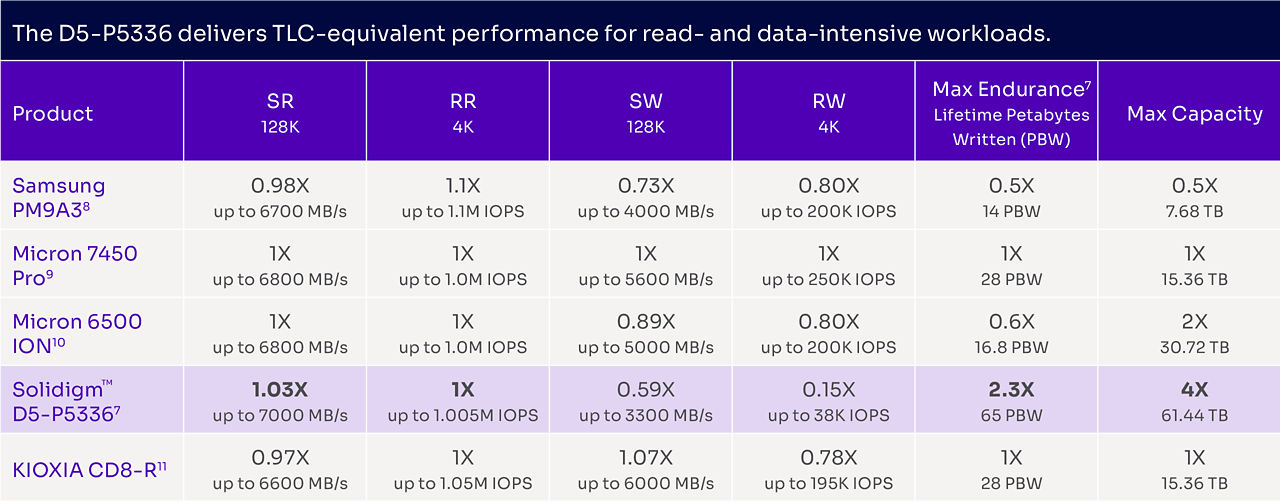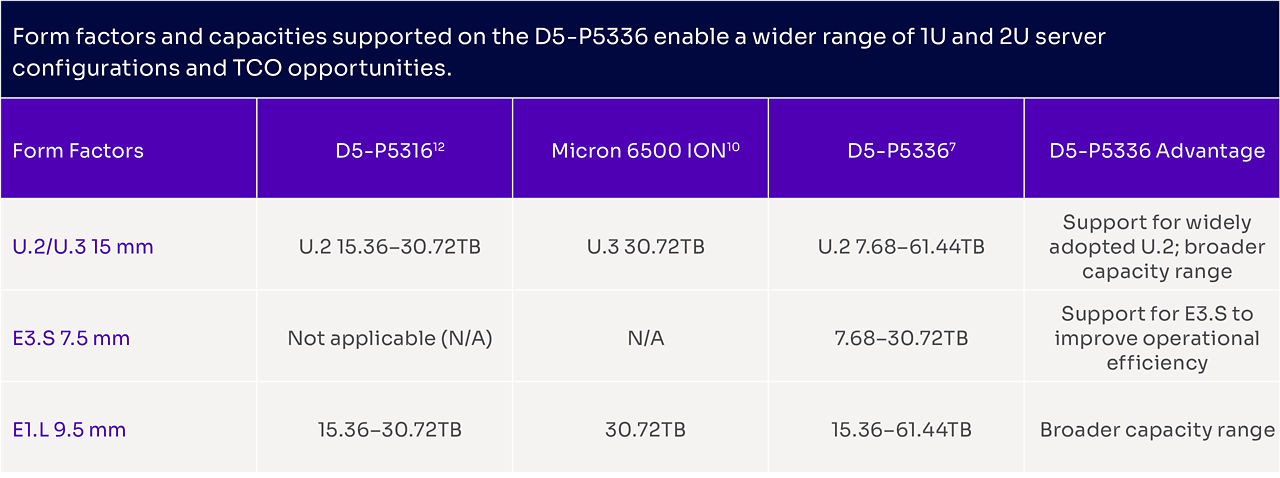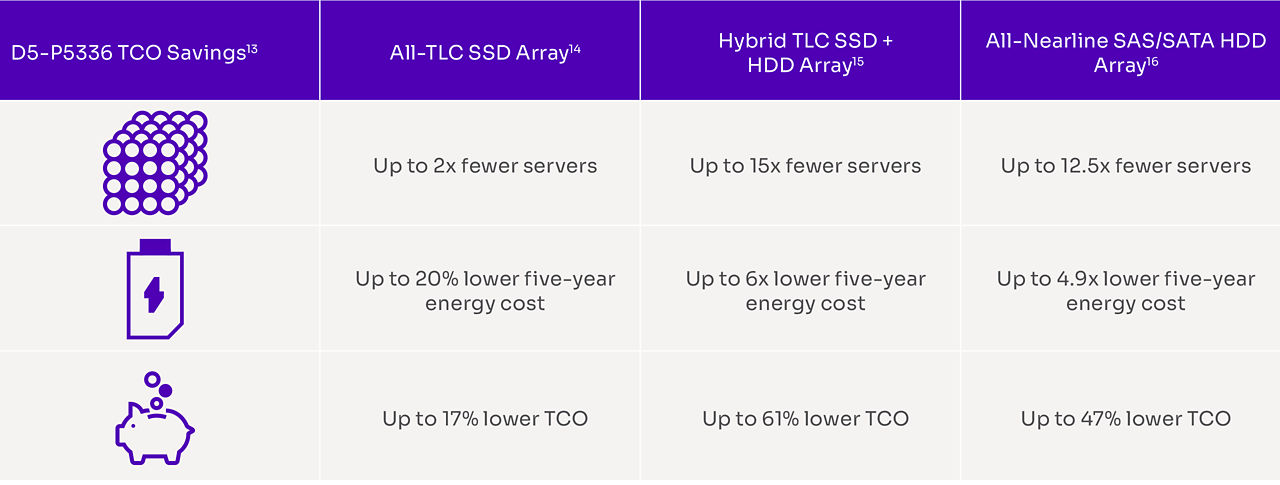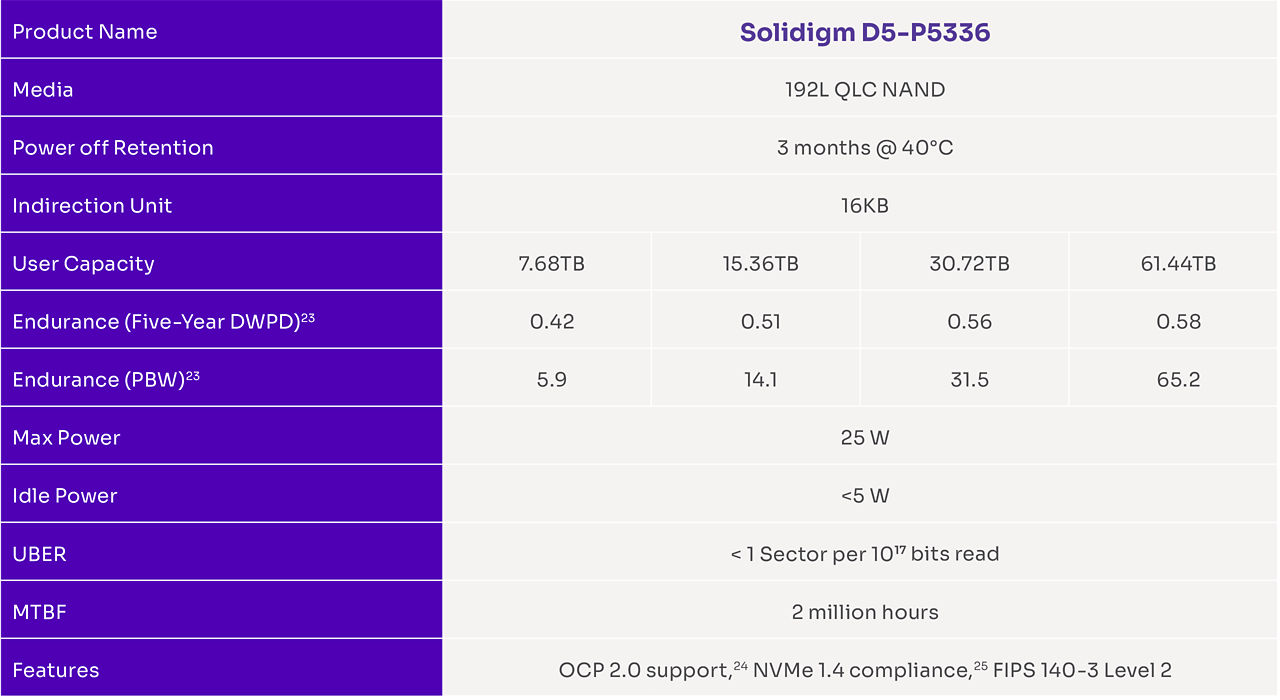Solidigm™ D5-P5336 Product Brief
The Solidigm™ D5-P5336 is part of Solidigm’s 4th generation QLC SSDs for the data center, delivering an industry-leading blend of high capacities up to 61.44TB with read-optimized performance and high value to read and data-intensive workloads.

Combining read performance exceeding that of some cost-optimized TLC SSDs and capacities up to 61.44TB [1] built on industry-leading NAND density [2], the Solidigm D5-P5336 has been architected to efficiently accelerate and scale increasingly massive data sets found in widely deployed read-intensive workloads—all while increasing storage density, reducing TCO, and enabling a more sustainable storage infrastructure than both TLC SSD- and HDD-based solutions.
Storage Density Matters
Widely adopted modern workloads are becoming even more data hungry. Many AI models are growing approximately 10X in size every two years [3]. Streaming services have shifted from limited paid for capacity to unlimited free capacity [4]. With connected IoT devices expected to reach 14.5 billion [5] by the end of 2023, supported by the tailwind of an accelerating 5G rollout, there is no end in sight to unabated growth in data-rich services and applications.
Accompanying this trend is the decentralization of compute and storage to the edge to improve service levels, reduce cost, and increase agility. As recently as 2018, only 10% of enterprise-generated data was created and processed outside of centralized data centers or cloud services. By 2025, Gartner expects 75% of that data to be created, processed, and stored at the edge [6]. Storage challenges such as space, power and cooling, sustainability, and serviceability become even more acute when considering locality constraints at edge deployments.
Optimized Capabilities for Read-intensive Workloads
In this environment, modern, data hungry workloads such as data pipelines and data lakes for AI, ML and Big Data Analytics, CDN, scale-out NAS, object storage, and edge usages are increasingly concerned with storing and accessing vast amounts of data efficiently at speed. The D5-P5336 is optimized for both requirements with read performance equivalent to TLC SSDs and capacities that are 2 – 3X higher than other storage alternatives.
The D5-P5336 delivers TLC-equivalent performance for read and data-intensive workloads.

Table 1. Product comparison of reads, writes, and endurance.
Form factors and capacities supported on the D5-P5336 enable a wider range of 1U and 2U server configurations.

Table 2. D5-P5336 form factors
Unprecedented Value From the Core to the Edge
Fast reads and massive, affordable capacities position the D5-P5336 quite favorably to reduce TCO and improve sustainability across a range of alternative configurations for read-intensive workloads. Higher density storage requires fewer servers to meet solution capacity needs, which reduces overall physical server footprints. This also equates to significantly reduced energy and power consumption. The table shows D5-P5336 value compared to legacy-based solutions when solving for a theoretical 100PB object storage solution .

Table 3. TCO savings of QLC D5-P5336 vs TLC and hybrid arrays
As noted earlier, the D5-P5336's capabilities extend to significant benefits at the edge as well.

Table 4. D5-P5336 benefits in edge storage applications
Deploy With Confidence
At Solidigm, we believe the two basic requirements of any storage device are to always be available and never return bad data.. While no storage can provide an absolute guarantee that these requirements are met, we apply our decades of experience and industry-wide deep technical engagements to relentlessly pursue these goals. It starts with design, where we add extra checks into our power loss protection to ensure data is saved accurately. In addition, we deliver highly robust full data path protection with ECC covering 99% of SRAM [17]. From there, we conduct test and validation procedures that go above and beyond industry specifications and common practices such as testing for UBER 10X beyond the JEDEC specification [18]. This thoughtfulness pays off when considering results such as AFR in high-volume manufacturing that is consistently better than our ≤0.44% goal [19] and, testing for resistance to silent data corruption (SDC) at Los Alamos National Labs spanning five product generations and more than 6 million cumulative years of simulated drive life that has shown zero SDC events [20].
Solidigm D5-P5336 Key Feature Overview [7]

Table 5. D5-P5336 specifications and features
All information provided is subject to change at any time, without notice. Solidigm™ may make changes to manufacturing life cycle, specifications, and product descriptions at any time, without notice. The information herein is provided “as-is” and Solidigm does not make any representations or warranties whatsoever regarding accuracy of the information, nor on the product features, availability, functionality, or compatibility of the products listed. Please contact system vendor for more information on specific products or systems. Performance results are based on testing as of dates shown in configurations and may not reflect all publicly available updates. See backup for configuration details. No product or component can be absolutely secure.
Performance varies by use, configuration and other factors.
Refer to the spec sheet for formal definitions of product properties and features. Nothing herein is intended to create any express or implied warranty, including without limitation, the implied warranties of merchantability, fitness for a particular purpose, and non-infringement, or any warranty arising from course of performance, course of dealing, or usage in trade. Tests document performance of components on a particular test, in specific systems. Differences in hardware, software, or configuration will affect actual performance. Consult other sources of information to evaluate performance as you consider your purchase.
Solidigm optimizations, for Solidigm compilers or other products, may not provide optimized performance to the same degree for non-Solidigm products. Solidigm technologies may require enabled hardware, software, or service activation.
Your costs and results may vary.
Solidigm does not control or audit third-party data. You should consult other sources to evaluate accuracy.
Some results have been estimated or simulated using internal Solidigm analysis or architecture simulation or modeling, and provided to you for information purposes only. Any differences in your system hardware, software or configuration may affect your actual performance. All product plans, roadmaps, specifications, and product descriptions are subject to change without notice.
The products described in this document may contain design defects or errors known as “errata,” which may cause the product to deviate from published specifications. Current characterized errata are available on request.
Contact your Solidigm representative or your distributor to obtain the latest specifications before placing your product order.
For copies of this document, documents that are referenced within, or other Solidigm literature, please contact your Solidigm representative.
All products, computer systems, dates, and figures specified are preliminary based on current expectations, and are subject to change without notice.
Product labels may differ.
* Broad availability Q4 '23
** Certification in process.
© Solidigm. “Solidigm” is a trademark of SK hynix NAND Product Solutions Corp (d/b/a Solidigm).Other names and brands may be claimed as the property of others
Footnotes
[1] Solidigm D5-P5336 U.2 and E1.L in 15.36TB and 30.72TB shipping now. All other capacities and form factors will ship later in 2023.
[2] Comparing density of Solidigm™ D5-P5336 of 18.6Gb/mm2 to Micron’s highest currently shipping density of 14.55Gb/mm2 Samsung’s highest currently shipping density of 10.59Gb/mm2 and Kioxia’s announced highest density of 10.4Gb/mm2 which is not currently shipping.
[3] Toward Data Science https://towardsdatascience.com/parameter-counts-in-machine-learning-a312dc4753d0
[4] Based on widely available research on streaming services such as Netflix, Hulu, Amazon Prime and Spotify.
[5] Orion Talent. “The Future of the Data Center Industry: Trends & Analytics for 2022 & Beyond.” May 2022. www.oriontalent.com/recruiting-resources/blog/575/data-center-trends.
[6] Gartner: What Edge Computing Means for Infrastructure and Operations Leaders
[7] Solidigm D5-P5336 product specifications and current 5 quarter roadmap. Endurance for 100% 16K RW for 61.44TB.
[8] Samsung PM9A3. Performance and PBW from highest capacity drive available. https://image.semiconductor.samsung.com/resources/data-sheet/Samsung_SSD_PM9A3_Data_Sheet_Rev1.0.pdf
[9] Micron 7450. Performance and PBW from highest capacity drive available. https://media-www.micron.com/-/media/client/global/documents/products/product-flyer/7450_nvme_ssd_product_brief.pdf
[10] Micron 6500 ION. Performance and PBW detailed at https://www.micron.com/products/ssd/product-lines/6500-ion
[11] Kioxia CD6-R. Performance and PBW from highest capacity drive available. https://americas.kioxia.com/content/dam/kioxia/shared/business/ssd/data-center-ssd/asset/productbrief/dSSD-CD6-R-product-brief.pdf
[12] Solidigm D5-P5316 product brief
[13] TCO calculations based on internal Solidigm TCO estimator tool. Public tool @ https://estimator.solidigm.com/ssdtco/index.htm will support Solidigm D5-P5336 TCO calculations after product launch. Key common consumptions across all comparisons: Power Cost = $0.15/KWHr; PUE factor = 1.60; Empty Rack Purchase Cost = $1,200; System Cost = $10,000; Rack Cost for Deployment Term = $171,200
[14] All-QLC configuration: Capacity - Solidigm™ D5 P5336, 61.44TB, E1.L 9.5mm, 7000 MB/s throughput, 25W average active write power, 5W idle power, 95% capacity utilization, RAID 1 mirroring All-TLC configuration: Capacity – Micron 6500 ION, 30.72TB, E1.L 9.5mm, 6800 MB/s throughput, 20W average active write power, 5W idle power, 95% capacity utilization, RAID1 mirroring; https://www.micron.com/products/ssd/product-lines/6500-ion
[15] All-QLC configuration: Single layer capacity - Solidigm™ D5 P5336, 61.44TB, U.2, 7000 MB/s throughput, 16W average active write power, 5W idle power, 95% capacity utilization, RAID 1 mirroring, calculated duty cycle 8.9% Hybrid configuration: Capacity - Seagate EXOS X20 20TB SAS HDD ST18000NM007D (datasheet), 70% short-stroked throughput calculated to 500 MB/s; 9.4W average active power, 5.4W idle power, Hadoop Triplication, 20% duty cycle Cache – Micron 7450 15.36TB, 6800 MB/s throughput, 16.6W average active write power, 5W idle power, 7% cache to capacity ratio recommended to meet customer SLAs; https://www.micron.com/products/ssd/product-lines/7450
[16] All-QLC configuration: Capacity - Solidigm™ D5 P5336, 61.44TB, U.2, 7000 MB/s throughput, 25W average active write power, 5W idle power, 95% capacity utilization, RAID 1 mirroring, calculated duty cycle 8.9%. All-HDD configuration: Capacity – Seagate EXOS X20 20TB SAS HDD ST18000NM007D (datasheet), 9.8W average active power, 5.8W idle power, 70% short-stroked throughput calculated to 500 MB/s; Hadoop Triplication, 20% duty cycle
[17] Edge density advantage vs. HDD comparing 61.44TB D5-P5336 to commonly available maximum capacity of 20TB as represented by 20TB Seagate EXOS 20. HDD capacity does not factor in any over-provisioning required to meet storage performance needs. Max 4 x 3.5” HDD or U.2 drives inspired by Open19 1U half brick server configuration. Edge density advantage vs. TLC SSD comparing 61.44TB D5-P5336 to 30.72TB Micron 6500 ION. Max 4 x U.2 or U.3 drives inspired by Open19 1U half brick server configuration.
[18] Weight efficiency vs. HDD comparing D5-P5336 61.44TB U.2: 61,440GB at 150 g = 409.6 GB/g vs. Seagate EXOS X20 20TB HDD SAS 3.5”: 20,000GB at 670 g = 29.9 GB/g. HDD capacity does not factor in any over-provisioning required to meet storage performance needs. Weight efficiency vs. TLC SSD comparing D5-P5336 61.44TB U.2: 61,440GB at 150 g = 409.6GB/g vs. KIOXIA CD6-R 15.36TB U.3: 15,360GB at 130 g = 118.1GB/g.
[19] Enhanced Power Loss Imminent: Additional firmware check validates data is saved accurately upon power restoration. Unclear if others provide this additional firmware check. Robust End-to-End Data Protection: Built-in redundancy where both ECC and CRC can be active at the same time. Protecting all critical storage arrays within the controller—instruction cache, data cache, indirection buffers, and phy buffers. ECC coverage of SRAM to more than 99% of array is among the highest in the industry.
[20] Uncorrectable Bit Error Rate (UBER) tested to 10x higher than JEDEC spec. Solidigm tests to 1E-17 under full range of conditions and cycle counts throughout life of the drive, which is 10x higher than 1E-16 specified in JEDEC “Solid State Drive Requirements and Endurance Test Method (JESD218).” www.jedec.org/standards-documents/focus/flash/solid-state-drives. Silent Data Corruption (SDC) modeled to 1E-25. Typical reliability demonstration tests involve 1K SSDs for 1K hours to model to 1E-18. Solidigm drives are tested at the neutron source at Los Alamos National Labs to measure SDC susceptibility to 1E-23 and modeled to 1E-25.
[21] Annualized Failure Rate (AFR) data as of March 2023. AFR is defined by Solidigm as customer returns less units that, upon evaluation, are found to be fully functional and ready for use.
[22] Solidigm drives are tested at the neutron source at Los Alamos National Labs to measure silent data corruption (SDC) susceptibility to 1E-23 and modeled to 1E-25. Tests prefill drives with a certain data pattern. Next, the neutron beam is focused on the center of the drive controller while input/output (I/O) commands are continuously issued and checked for accuracy. If the drive fails and hangs/bricks, the test script powers down the drives and the neutron beam. The drive is subsequently rebooted, and data integrity is checked to analyze the cause of failure. SDC can be observed during run time causing a power down command, or after reboot if the neutron beam has hit the control logic, hanging the drive as a result of in-flight data corruption. Because drives go into a disable logical (brick) state when they cannot guarantee data integrity, brick AFR is used as the measure of error handling effectiveness. Solidigm drives have used this testing procedure across four generations. Cumulative testing time across generations is the equivalent of more than 6M years of operational life in which zero SDC errors have been detected. The most recent testing used the Solidigm D5-P5520 drives, which served as a proxy for the Solidigm D5-P5430 drives because they share the same controller and similar firmware. Competitor drives tested were the Samsung 983 ZET, Samsung PM9A3, Samsung PM1733, Micron 7400, Micron 7450, KIOXIA XD6, Toshiba XD5, and WD SN840.
[23] IU-aligned endurance, based on 100 percent RW 16 KB workload calculation.
[24] See D5-P5336 product specification for exceptions and modifications for compliance/support details.
[25] Q1 SKUs compliant with NVMe version 1.4 and NVMe MI 1.1. NVMe 2.0 and NVMe-MI 1.2 support to be targeted in PRQ2 and subsequent releases.